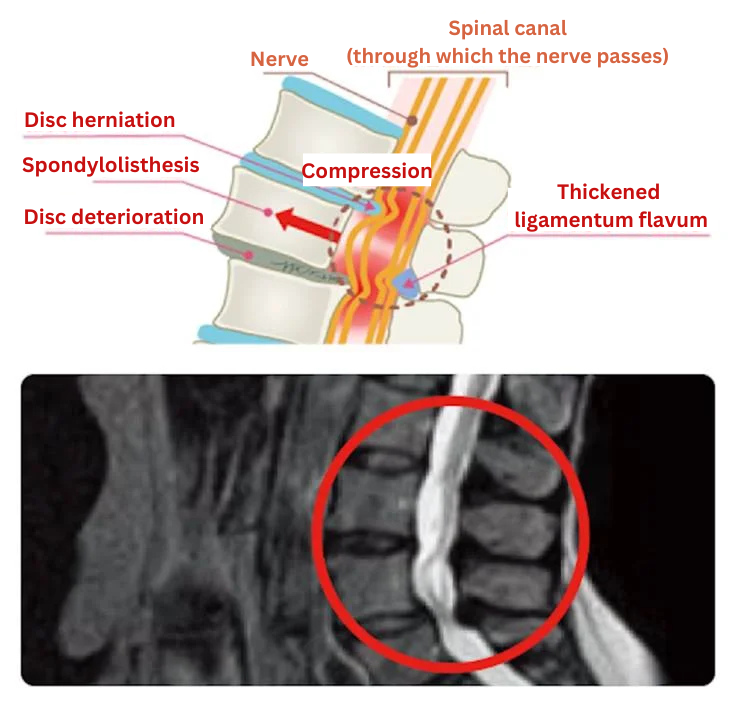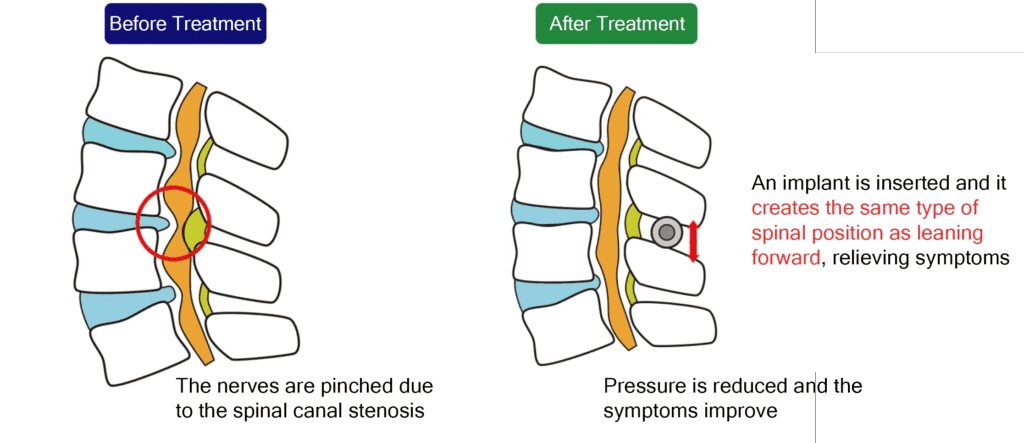Column Treatment of Spinal Canal Stenosis: The Various Conservative Treatments and Surgical Options
June 12, 2025
Spinal canal stenosis is the most common disease, along with disc herniation and spondylolisthesis, according to a survey report on spinal surgery by the Japanese Society for Spine Surgery published in 2004 (*1).
*1 Reference: Yutaka Nohara et al, “Spinal Surgery Survey Report of the Japanese Society for Spine Surgery,” Journal of the Japanese Society for Spine Surgery, Vol. 15, No. 2, 2004.
In this issue, we will explain the various treatments for spinal canal stenosis.
What is spinal canal stenosis?
Spinal canal stenosis is a condition in which the spinal canal, the pathway for nerves, becomes stenosed (i.e., narrowed), thereby causing compression of the nerves. When it is caused by instability of the lumbar spine, physical movement will often cause pain.
In the case of lumbar spinal canal stenosis, pain and numbness will usually appear from the waist down. It is also characterized by intermittent claudication, a condition in which walking causes pain and numbness in the buttocks and legs, which eases after a short rest, only to return when the patient resumes walking.

Treatment of Scoliosis: Conservative Therapy
Pharmacotherapy
Oral anti-inflammatory and analgesic medications are recommended when pain and numbness appear in the lower back and lower limbs. Depending on the symptoms, intravenous drips or injections may also be used.
Since the indications and effects of medications and injections may vary from person to person, make sure to consult with a qualified doctor rather than make decisions on your own.
Medication can relieve symptoms, but may not cure the disease fundamentally.
Be aware of the side effects and take medication according to the doctor’s instructions.
Depending on the severity of the symptoms and the patient’s condition, this may be combined with physical therapy.
Physical therapy
Physical therapy can relieve the symptoms of spinal stenosis by improving the movements of the spine.
・Exercises to improve spine mobility
The purpose of these exercises is to improve the flexibility of the body and the mobility of the spine from the pelvis to the spine.
1. Raise both knees and slowly lower them sideways, starting from the knees.
2. As you roll sideways, be careful to first move the knees, pelvis, and hips, in that respective order.
Make sure to focus on moving the pelvis first, then the hips.
3. Perform this exercise slowly for 2 to 3 minutes without stopping.

・Exercise to improve the mobility of the spine
The purpose of this exercise is to enable spine mobility by leveraging the strength of the abdomen.
By improving the mobility of the spine, the strain on the lower back caused by standing up and walking can be alleviated.
1. Place your hand below your navel.
2. Exhale through the nose and press down on the area where your hand is placed.
3. While continuously pressing that area, raise your buttocks without lifting your back
4. Once you have lifted your buttocks, lower them slowly
5. Focus on moving the lumbar vertebrae (lower back spine) from the pelvis up when lifting your buttocks.

Treatment of spinal canal stenosis: surgery
Surgery is recommended when there is no improvement or insufficient results with conservative treatment, or when symptoms are progressing.
Surgical procedures: lumbar discectomy and spinal fusion
The most common surgical procedures for spinal canal stenosis are lumbar discectomy and spinal fusion.
Lumbar laminectomy is performed under general anesthesia. Whikle using an endoscope, the skin of the back is cut open and part of the vertebral arch and the thickened ligamentum flavum are removed to relieve nerve compression and widen the spinal canal.
Spinal fusion is performed under general anesthesia by making an incision in the skin of the back, removing the degenerated disc, and placing a cage filled with bone taken from the hip bone while the vertebrae are secured with screws and rods. It may be performed consecutively to a lumbar laminectomy.

Once surgery is performed for spinal stenosis, it is not uncommon for the spinal canal to narrow once again afterward, causing a recurrence of symptoms. In such cases, a high percentage (10% to 23%) will require further surgery (*1).
Comorbidities also increase the incidence of postoperative complications and lengthen recovery time. The incidence of comorbidities is particularly high in elderly patients, ranging from 60% to 73.9%. (*2).
Among them, diabetes, respiratory distress, chronic obstructive pulmonary disease, and the use of steroids in conjunction with chronic diseases increase the risk of postoperative complications (*3).
(*1): Atlas SJ, et al. Long-term outcomes of surgical and nonsurgical management of lumbar spine stenosis: 8 to 10 year results from the maine lumbar spine study. Spine, 2005, 30(8). Kim CH, et al. Reoperation rate after surgery for lumbar spinal stenosis without spondylolisthesis: a nationwide cohort study. Spine Journal, 2013, vol.13-10.
(*2): Khalepa R.V., Klimov V.S. Lumbar spinal stenosis in elderly and senile patients: problem state and features of surgical treatment. Russian journal of neurosurgery. 2017;(1).
(*3): Deyo, R. A., Hickam, D., Duckart, J. P., Piedra, M. Complications After Surgery for Lumbar Stenosis in a Veteran Population. Spine. 2013;38(19).
Minimally invasive procedures: the Florence and Q-Florence methods
The Florence and Q Florence methods ar another way to treat spinal canal stenosis.
The Florence and Q-Florence procedures are minimally invasive, low-risk treatments for spinal canal stenosis.
Under partial anesthesia and sedation, a device is percutaneously inserted to widen the narrowed spinal canal.
The device can be inserted to stabilize the vertebrae while preserving spinal rotation and flexion, widening the spinal canal and reducing disc protrusion and the thickening of the ligamentum flavum. Pain is eliminated as a result of widening the stenosed spinal canal.
The Florence and Q-Florence methods are minimally invasive and low-risk procedures, with no post-treatment complications or recurrence of symptoms reported so far.

The Q-Florence Method (article in Japanese)
Choosing the right treatment for spinal stenosis
The decision about which treatment is appropriate for the patient should be made in consultation with the doctor.
The following are some of the criteria for choosing the appropriate treatment.
Severity of the symptoms
If symptoms are mild, conservative therapy (medication and physical therapy) is often the initial choice.
If there is no improvement with conservative therapy, surgery is then considered.
Surgery is necessary if there is muscle weakness in the lower limbs, paresthesia, or bladder and bowel disorders.
Existence of additional medical conditions
If lumbar instability is also present in conjunction with spinal stenosis, a more invasive surgery such as fusion surgery may be required.
If the patient has pre-existing medical conditions such as diabetes or chronic diseases, the type of surgery should be carefully selected, taking into consideration whether the patient can endure general anesthesia and whether it will interfere with his/her postoperative rehabilitation.
Cost
Depending on the medical facility and the type of surgery, insurance may or may not cover the surgery (conventional surgical procedures) or it may not ( on-the-day minimally invasive procedures).
Conventional surgical procedures require a period of hospitalization, and the cost of hospitalization is not included in the cost of treatment. The longer the hospital stay, the higher the cost.
Returning to work after surgery
When choosing surgery for spinal stenosis, the process of returning to work after surgery can also be a factor in the decision. Conventional surgery involves a period of hospitalization after the procedure and may require staying in bed for a certain period of time. If you do not have the luxury to take time off work or have no one to help you with the housework at home, a one-day surgery that does not require hospitalization is usually recommended.
If you suffer from spinal canal stenosis, please consider a consultation at our clinic.
Related Articles
Lumbar Spinal Canal Stenosis: Just What is Actually Happening to my Body?
The Different Symptoms of Spinal Canal Stenosis: If You Have Any of These, it’s a Red Flag!
What are the Various Complications Possible With Spinal Stenosis?
Why Do the Symptoms of Spinal Stenosis Differ From Person to Person?
Diagnosis and Treatment of Spinal Stenosis: Why Early Detection is Critical
Spinal Canal Stenosis, Progression and Symptoms: Of the Importance of Early Detection



